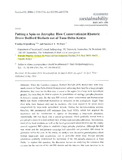Factors Influencing The Price Of Land In Nakuru County
The objective of the study was to find out the factors influencing land prices in Nakuru County. This was prompted by the recent upsurge of land prices in the country and the researcher was particularly interested in Nakuru County. The real estate sector experiences a series of booms and busts and it was therefore important to find out what is causing them.









